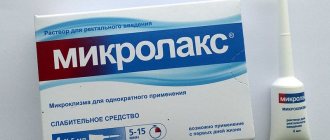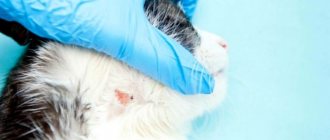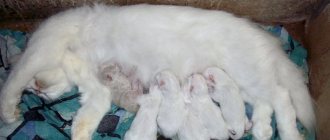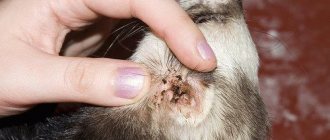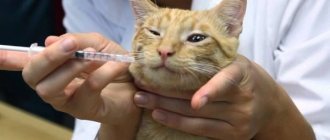Cats, just like people, have a fairly high risk of injury every day. Nevertheless, these animals sometimes become injured, and the wounds begin to fester. In this article you can learn how to avoid wounds from festering , as well as how to treat purulent wounds in cats . In order not to get confused or panic, we recommend collecting as much information as possible on this disease.
Drugs
Today, in the pharmacy chain you can purchase a large number of medications that disinfect the wound. Accordingly, the choice of medication directly depends on the wound surface, its size, depth and the possibility of further infection. Treatment measures, prevention of secondary infection and eradication of surface healing depend on these factors.
Hydrogen peroxide
Treatment with this drug is possible no later than 2 hours from the moment of injury. Do not pour the bottle directly onto the wound. It is better to moisten the swab with the solution and treat the surface. If possible, apply a sterile dressing. But remember that during treatment you must hold your pet tightly.
Levomekol ointment
Used to accelerate wound healing and to prevent infection. The main active component accelerates metabolic processes in tissues and promotes the removal of purulent contents. To treat and prevent further infection, apply a bandage to the surface of the wound.
Baneocin ointment
It is excellent for treating infected wounds. The drug is not addictive and can be used up to 2-3 times a day. After treatment, it is recommended to cover the wound with a sterile cloth.
Iodine solution
Important! Do not apply the product directly to the wound surface. Dissolved iodine can be used to treat the edges of the wound without touching the wound itself. But, if there is a weeping wound, iodine will dry the surface, thereby protecting the animal from further infection.
Brilliant solution
Treating the wound with brilliant green should be done very carefully to avoid burns. It is not recommended to treat a weeping or bleeding wound with brilliant green. At its core, brilliant green solution is a powerful external antiseptic. Penetrating into the wound surface, it destroys pathogenic microorganisms and prevents the proliferation of bacteria.
Therefore, it is better to apply an aseptic dressing treated in a solution of brilliant green to the wound surface.
Furacilin solution
Furacilin still occupies a leading position for wound treatment. As a rule, to prepare a solution, 20 mg tablets are prescribed, which must be dissolved in 100 ml of water. The prepared solution should be stored in the refrigerator. The wound surface is treated with the product 2-3 times a day.
Rinse should be done away from the wound if it is fresh, and towards the wound if it has an inflammatory process.
First aid
After discovering a wound on your pet, give him first aid. Examine the cat and assess its condition; if it does not cause concern, then you can provide first aid yourself.
First aid:
- remove hair near the wound;
- wash the wound with antiseptic drugs - furatsilin solution, hydrogen peroxide, chlorhexidine;
- try to stop the bleeding;
- the skin around the wound can be treated with brilliant green.
After providing first aid, take the animal to a veterinarian. The doctor will select the optimal treatment regimen and show you how to properly carry out the treatments.
How to care for a cat during the recovery period?
Watch the cat. If the wound was small and the animal immediately received adequate help, there should be no lethargy, drowsiness, vomiting, diarrhea or other “strange” signs. In the event that you observe something similar to your slightly injured pet, immediately call a veterinarian. These clinical signs clearly indicate a sharp deterioration of the pathological process.
Important! Discourage your cat from constantly trying to scratch the wound, tighten the post-operative bandage, or remove the drainage from the wound channel. Let us note, by the way, that for any wound, cats need a surgical (aka Elizabethan) collar, since otherwise they will definitely lick the damaged tissue.
If your pet is completely restless, it is recommended to use “aggressive” models that give a slight electric shock when trying to get rid of the collar. T-shirts and rompers for babies can be used as a “budget option”: if the animal is pulled into them, it will no longer be able to reach the wound (well, at least it will get very tired). Of course, the “clothes” need to be changed more often.
If you see that the edge of the drainage has appeared from the canal , be sure to inform the treating veterinarian about this. It is believed that the ideal time to replace drainage is every 12 hours. But in reality, it is rare that an owner can take a pet to the veterinarian with such frequency. There are two ways out: either do the replacement yourself, or extend the period to 17-20 hours. In principle, there is nothing wrong with this. If the wound looks clean, dry and closed, you can leave the drainage system without any fear: nothing bad will happen. Just make sure your cat can't lick the wound.
When to go to the veterinary clinic
You should contact your veterinarian if you have the following signs:
- prolonged bleeding from the wound;
- damage where meat and torn pieces of skin are visible;
- increased body temperature in the pet, lethargy, lack of appetite;
- the appearance of vomiting and diarrhea;
- wounds with a large area;
- gunshot wounds;
- the appearance of swelling and redness in the affected area;
- pus or abscess;
- in case the pet is bitten by a tick;
- if your pet has been bitten by a snake and there is poison in the wound.
Important! If, as a result of home treatment, the wound does not improve within a few days, you should consult a doctor.
Processing rules
As a rule, a cat receives a wound on the street while defending its territory or during the period of sexual heat. The resulting wounds can be of a different nature.
Weeping wound
Weeping wounds are treated dry, provided that the pet does not remove the bandage. If there is purulent exudate, you can apply a gauze pad soaked in a hypertonic solution of table salt or Vishnevsky ointment to the wound. But such treatment will be successful only if tissue regeneration is going well.
If there is no improvement, then surgery should be resorted to to resect the necrosis.
Deep
If the wound surface is deep enough, then treat it with a solution of Chlorhexidine or Miramistin, carefully inserting the nozzle of the bottle into the wound. Next, you need to inject Levomekol ointment into the cavity using a syringe without a needle. Procedures must be performed 2-3 times a day until complete healing. You should also put on a special collar for your pet so that he does not further injure the wound surface by licking it.
In any case, try to get an appointment with a veterinarian as soon as possible to adjust the treatment.
Open
The first step is to treat the surface with hydrogen peroxide. If the wound surface is large and without purulent discharge, then you can treat it with Novocaine solution for pain relief, just by pouring a little on it. Then you can sprinkle streptocide powder on it, it disinfects the surface and promotes speedy healing.
Bleeding
The first step is to stop the bleeding. To do this, clamp the surface with your hands or bandage it tightly. You can also apply a tourniquet above the injury and attach a note indicating the time of application. The tourniquet should not be on the wound for more than 2 hours. For shallow wounds, treat with hydrogen peroxide.
Important! Do not use disinfectants as they can cause severe irritation and slow down healing.
After emergency measures are taken, the animal should be taken to the clinic for treatment.
With purulent discharge
Hydrogen peroxide or chlorhexidine are suitable for disinfection. To prevent the spread of infection, you can give an injection of an antibiotic, for example, Sinusol 50 mg. The full course of treatment is 7 days.
If there is pain, heat, swelling or hyperemia in the wound area, you should immediately contact a veterinary clinic. This may indicate the development of an abscess, which requires professional treatment.
Superficial
Initially, you should wash the wound with hydrogen peroxide. Then treat with Baneocin or Neosporin. It is recommended to apply ointments up to 3 times a day. If possible, try not to cover the wound surface with a bandage. With air access it will heal faster.
Burn
Treatment of burns depends directly on their severity. Initially, you need to apply a cold compress to the damaged surface for 20 minutes. Then treat it with a weak solution of potassium permanganate or anti-burn ointment. Then apply a sterile gauze bandage to the surface.
After this, it is necessary to show the animal to a doctor to prescribe effective treatment.
If meat is visible
Initially, you should treat it with 3% hydrogen peroxide. Afterwards, you can apply brilliant green around the wound surface, and sprinkle the wound itself with Baneocin or treat it with Sanotol spray. After this, apply a sterile gauze pad and immediately contact a veterinarian.
How to treat if the wound does not heal on the paw
It happens that a cat has injured its paw and quite some time has passed, but the wound still does not heal. In this case, it is imperative to treat it with medications so as not to lead to severe infection. Sometimes a similar situation occurs when suppuration begins. Treatment will be required for disinfection three times a day and only then wound healing.
It is very important not to allow the cat to lick the wound, because he may thereby lead himself to repeated suppuration. To do this, cover the wound with a sterile bandage and seal it with a plaster. And you should definitely take your pet to the vet. In especially severe cases, it is impossible to do without laser irradiation of the wound, injections of antibiotics, special vitamins and food to promote its speedy healing. The main thing is to understand the seriousness of the cat’s injury and treat it responsibly.
The diet of a cat with purulent wounds also affects the treatment of purulent wounds in cats
A cat with festering wounds is very sensitive
. All smoked meats, sausages, sweets that should not be given to even healthy cats, and fatty meats should be removed from the diet. A festering wound will heal faster if you eat healthy, natural foods, for example, vegetables, boiled chicken, and fish. Remember healthy, dietary food in hospitals and sanatoriums. You will never find sausage or unhealthy smoked brisket there. During the period of active recovery, it is very advisable to give your pet synthetic vitamins that will help maintain the health of the furry.
Features of care and feeding patterns for cats with wounds
A cat that has been diagnosed with a wound should be kept at rest until all injuries are completely healed. It is not recommended to let such a pet outside, and it is also necessary to protect it as much as possible from contact with other animals. Feeding plays an important role in the rehabilitation process of a cat with a wound. It must be balanced and aimed at fighting infection:
- Foods with irritating effects should be removed from the cat’s diet: smoked meats, sausages, sweets;
- it is necessary to increase the amount of vegetables, which contain vitamins and microelements necessary to stimulate the immune system;
- Additionally, you can give a sick cat synthetic vitamin complexes prescribed by a veterinarian.
How to speed up wound healing
To speed up the healing of the wound surface, you should strictly follow the veterinarian’s recommendations. You can also use special long-acting wound-healing wipes for cats, for example, Antivtex. The use of antibiotics prescribed by a doctor will also promote rapid regeneration of the surface.
In addition, it is necessary to provide the animal with complete rest and prevent licking the surface. To do this, you need to use special collars and tightly secured gauze bandages that the pet cannot remove on its own.
Possible complications
Through the scratches of a domestic cat, a person can become infected with many rather unpleasant infections. One of them is felinosis or cat scratch disease. This type of pathological process is characterized by acute bacterial damage to the body.
A cat's claws, located at a special angle, easily penetrate the skin, injuring several layers of the dermis at once. Pathogenic microorganisms located on the paws and claws of an animal penetrate the human body. Animal saliva contaminated with foreign bacteria can also provoke the development of felinosis in humans.
The infection caused by Bartonella adapts perfectly in the animal’s body, circulating in urine, bloodstream and saliva. Naturally, bartonellosis is also found on cat paws.
In the first stages of felinosis development, a person experiences an inflammatory process in the tissues of the lymph nodes. In cats, bartonellosis is transmitted through the bites of blood-sucking parasites. After damage to the tissues of the lymph nodes, edema develops, body temperature increases, signs of poisoning and even an allergic reaction arise.
Felinosis poses the greatest danger to young children and adults with weakened body defenses (especially after suffering from a dangerous disease). It is important to note that BCC is not transmitted from person to person.
There are several forms of felinosis - typical and atypical. The first type of disease is characterized by moderate development. At the site of the injury (healed), a small blister begins to form, which bursts and forms a small ulcer covered with a crust. A person’s well-being does not change much.
Symptoms
In a cat, an abscess can form several times throughout its life. In this regard, the animal owner must clearly understand how to promptly recognize the development of purulent inflammation in order to provide timely assistance.
The abscess develops gradually, one stage follows another. The earlier the inflammation was detected, the higher the chances of successful and painless treatment. Early stages of abscess formation, especially subcutaneous ones, can be successfully treated with conservative treatment without the use of surgical excision.
Inflammatory processes accompanied by the formation of purulent exudate are quite easy to identify if you regularly examine your pet for damage. The same applies to abscess of the paraanal glands. This pathology does not develop suddenly; it is preceded by characteristic changes.
For all types of purulent inflammation localized under the skin, the following signs are observed:
- Hyperemia of the affected area on the skin or mucous membrane (diagnosis of an abscess at this stage is possible by palpation; it is more difficult to do this visually).
- Severe swelling (a cavity begins to form in the affected area as the inflammatory process develops).
- Fluctuation is a kind of edematous swelling that occurs against the background of accumulation of purulent exudate in the cavity.
- Areas of baldness - hair begins to fall out at the site of the lesion (a similar symptom is especially pronounced when an abscess forms on the paw).
- The appearance of areas of necrosis - develops at later stages in animals suffering from insufficient functioning of the immune system (in cats with a good immune status, the resulting abscess bursts on its own, and the contents come out, otherwise, the pyogenic microflora begins to corrode the surrounding healthy tissue, provoking the development necrosis).
An abscess that occurs in a cat on the cheek from the inside or outside, as well as in the jaw, ear or upper part of the head, is characterized by an increase in local body temperature, decreased appetite, and severe pain. The cat looks weak.
In the absence of timely therapy, there is a risk of infection of healthy tissue structures located in close proximity to the abscess. Necrosis subsequently develops, and the infection can penetrate the systemic bloodstream. Sepsis (blood poisoning) develops, which can lead to the death of the pet.
Failure to treat a perianal abscess in a timely manner is especially dangerous. This is due to the fact that in the absence of therapy, which includes conservative and surgical techniques, a self-opening abscess with exudate provokes the formation of a fistula. Sepsis often develops against the background of a perianal abscess.
Treatment with antibiotics
Antibacterial drugs are used to prevent secondary infection. As a rule, the remedy is selected by a veterinarian depending on the wound surface. The doctor will also prescribe the exact dosage. The most commonly prescribed drugs are tetracyclines, Ampicillin, Streptomycin. For infection of the wound surface, Amoxicillin, Clindamycin or Benzylpenicillin are recommended.
To summarize, we can say that only a veterinarian can determine how to treat a cat’s wound for effective treatment. After all, the healing process directly depends on correctly selected drugs. In any case, after providing emergency care to your pet, it must be shown to a specialist. Only a veterinarian can prescribe medications that will speed up the healing process and prevent secondary infections from occurring.
How to treat a wound, instructions from a veterinarian
Types of wounds
Quite curious and ubiquitous cats regularly get injured in domestic conditions, especially when they have free access to the street. Walking on rooftops or climbing trees does not always end well. In some cases, a cat may become the target of an aggressive dog, suffering serious lacerations.
It is important to know how to properly treat a cat's wound to avoid complications such as suppuration and infection of large areas of tissue around the wound.
In anatomical terms, a wound is damage to the integrity of the skin or any type of mucous membrane. The main distinguishing features of a wound from other types of damage are the nature of the symptoms. Thus, the wound is characterized by noticeable pain, hemorrhage and gaping.
Pain and bleeding, as well as the size of the wound surface depend on what caused the damage and what object played the main role in this. There are several types of wounds, the main ones are:
- Incised wound – occurs against the background of trauma caused by a sharp object. Such a wound is always open, and the tissue structures are slightly destroyed. The edges of the wound are even and smooth, and the skin regenerates quite quickly. An incised wound occurs as a result of breaking the integrity of the skin with knives, glass or razor blades.
- Puncture wound - appears as a result of exposure to sharp thin objects. The animal can be injured by knitting needles or an awl. A distinctive feature of puncture wounds is a narrow entrance hole and a fairly deep internal cut. Quite often in the practice of veterinarians, a small edge of a puncture wound is healed, and the outflow of exudate in the wound stops. As a result, suppuration occurs and the installation of a drainage system is required. A purulent wound is the result of an untreated puncture wound.
- A chopped wound is a consequence of the impact of sharp objects on the skin of an animal. Sharp objects injure tissue at an angle, which provokes, in fact, widespread damage, accompanied by bruising of soft tissue structures. This type of wound in a cat is considered average between a cut and a bruised wound. The chopped wound is characterized by severe pain and severe bleeding.
- Bruised - occurs against the background of blows from blunt objects. A large surface of the skin is damaged, and the muscle fibers under the skin are crushed. Such a wound is completely soaked in blood. As a result of disruption of the vital functions of skin cells at the site of impact, the onset of necrotic processes is often recorded. The danger of a bruised wound is the high risk of infection.
- A crush wound is the result of unusually severe injuries from blunt objects. Such a wound is characterized by a gaping, soft tissue structures are crushed to such an extent that they can rarely be restored. Crushed wounds are usually accompanied by fractures of bone structures and are most often diagnosed on the paws.
- A laceration in a cat occurs due to a rupture of the skin. Characteristic features of this type of wound are severe pain, hemorrhage, uneven edges and a large gape. When the top layer of skin is completely torn off or partially removed, the wound is said to be scalped.
- Bite wounds are a type of injury received by cats when bitten by dogs, relatives or other animals. This type of wound poses the greatest danger because there is a high risk of introducing pathogenic bacterial or fungal microflora from the oral cavity of the animal that bit the cat into the wound surface. In most cases, such a wound is diagnosed on the neck, head or paws. It is worth remembering that bite wounds pose the greatest danger to your pet, as they often cause complications. In addition, most dangerous diseases are transmitted through direct contact (in particular, rabies).
- A wound poisoned by a toxic substance . Poison penetrating onto a damaged surface can cause serious consequences, corroding the wound. A weeping wound in a cat often occurs due to poisoning from serious poisons from household chemicals or from other poisonous insects or animals.
- Wounds caused by firearms . This type of wound in cats is more common in urban environments. There are a large number of animal “lovers” who consider themselves cleaners by shooting stray animals. Shots from a traumatic weapon rarely lead to the death of an animal, but seriously injure it. A free-ranging domestic cat can easily become a dog hunter's target.
In veterinary medicine there is also a mixed type of wounds, which combines several of the above individual types - cut-puncture, bruised-lacerated. The presence or absence of pathogenic bacterial or fungal microflora in the wound surface makes it possible to divide wounds into infected and aseptic.
Find out also what types of injuries a cat can have>>>
The appearance of a wound on a cat’s body is difficult to ignore. Characteristic signs of a wound in a cat are the appearance of an abrasion or a cut. A gaping wound bleeds, depending on the degree of damage, more or less. The damaged surface brings significant pain to the pet, swelling and inflammation occur.
Without proper timely treatment of the damaged area, suppuration develops. If the wound is open and not healed, purulent exudate is released out, drying out in the form of characteristic crusts. When the wound is closed, the purulent contents remain inside, provoking more serious changes - an abscess or phlegmon. To prevent such phenomena, you need to know how to properly treat damaged skin at home.
Why are scratches from a cat dangerous?
Scratches from cats and bites from these domestic pranksters are much more infected than bites from domestic dogs. In the overwhelming majority, infectious agents located on the paws and claws of cats are not isolated. Polymicrobial flora contains streptococcal infection, staphylococcal bacilli, pasteurella and some others. It is worth noting that bacterial pathogenic microorganisms are present on the paws and claws of all cats, without exception, even the most domestic and well-groomed ones.
In addition to the bacteria described above, after a scratch a person may develop the so-called felinosis, or cat scratch fever. The marks left by a cat on the owner's body are not harmless. Cat scratch disease can cause quite serious allergic reactions in humans and provoke dangerous complications in the organs of the human body.
The spread of pathogenic bacterial pyogenic microflora is due to the fact that the claws of domestic and wild cats have a curved shape. With the help of its weapon, the cat breaks the surface layer of the dermis. As a result of the penetration of pathogenic microflora that provokes BCC, first of all, the size of the lymph nodes changes. Wounds caused by a cat take a long time to heal, as they are not even.
Cat scratches have jagged edges, which delays the regeneration and recovery process. Deep torn scratches transform into a closed type of damage. It accumulates dirt and pathogens. Before treating a wound surface formed by a cat’s claws, it is necessary to thoroughly treat it to remove all kinds of dirt and infection, which will allow the body to easily regenerate the damaged area with new tissue.
Why you shouldn't ignore cat scratches
The causative agent of lymphoreticulosis, or non-bacterial lymphadenitis, lives in the body of many cats. At the same time, the animal itself is not sick and looks cheerful and healthy. The infection is transmitted to humans through scratches and bites. If, despite all the measures you have taken, the scratches begin to become inflamed, reddened or rotted, consult an infectious disease specialist.
Based on the results of the examination, you will be prescribed treatment. Most often, the doctor prescribes antibiotics for internal and external use. The course of treatment depends on the severity of the disease and ranges from 7 to 14 days.
Do you want to avoid such consequences from communicating with your beloved Murka? Get your cat vaccinated on time. It is worth noting that even a vaccinated animal can become infected again if it goes outside unhindered. Therefore, you should not let your guard down. After all, even their beloved owner can be scratched.
What does the veterinarian do?
- After examining the wound, the specialist carries out his treatment, adhering to all the rules of purulent surgery, asepsis and antisepsis. If necessary, stitches are applied (skin, sometimes muscles with blood vessels are sewn). When sewing, local anesthesia or anesthesia must be used, depending on the complexity of the surgical operation and the location of the injury. The sutures are removed after 10-14 days or are not removed if they were applied with self-absorbable suture material.
- When applying sutures, a small hole must be left so that there is a drain for the resulting wound fluid (exudate), which should not remain in a blind wound, because this will definitely cause suppuration and the formation of a purulent abscess.
- In case of extensive wounds and the presence of pus, a course of antibiotic therapy with broad-spectrum antibacterial agents must be prescribed to avoid sepsis (most often it is ceftriaxone diluted with novocaine, since in cats lidocaine should be used with extreme caution or oxytetracycline if daily injections are not possible).
- A protective bandage may or may not be applied. Everything will depend on the condition of the wound and its accessibility to licking, as well as on the part of the body where it is located. In areas of constant mechanical irritation, it is better to try to apply a bandage, and to prevent licking, you can put on a special collar. Open wounds heal somewhat faster than closed and bandaged wounds, especially for purulent processes, because suppuration is most often caused by anaerobic bacteria (reproducing without access to air), and oxygen in this case will additionally kill them.
- In case of extensive blood loss, the veterinarian prescribes drips to replenish the lack of blood plasma.
- Bite wounds are often accompanied by the formation of abscesses - limited cavities filled with pus. Such areas are opened and necessarily drained, i.e. an area is formed for the drainage of inflammatory exudate, which cannot close until the inside of the wound is completely cleansed. Through the holes, the wound is washed daily with a 3% hydrogen peroxide solution until the wound is clean. Then the drainage is removed, the wound is treated like a normal injury until complete healing.
- In rare cases, a skin transplant may be required if your internal resources for restoring the skin are not enough.
- The average healing time for a wound in a cat (uncomplicated and medium-sized) is 7-16 days. But you need to understand that this period is quite arbitrary and each organism is very individual, so the time frame may increase. In this case, dynamics are important - if the healing process is obvious, then time is not so important.
- If the healing process is under the constant supervision of a specialist, then ongoing adjustments and changes in medications are possible to increase its effectiveness. In case of prolonged non-healing and absence of positive dynamics (more than 3-4 weeks), bacterial culture from the wound may be necessary (not only from the purulent discharge itself, but from places on the border between the wall of the beginning of the purulent process and the discharge itself).
Felinoz and cats
There is a disease called felinosis, which is also called cat scratch disease. Felinosis develops under the influence of bacteria that are introduced under the skin from an infected cat. If a cat is sick, then by licking, biting or scratching it can make a person infected, and after this quite unpleasant effects begin to develop.
- The initial stage is contact with the cat.
- Next, swelling and a small ulcer appear.
- After at least one week, a slight fever and inflammation of the lymph nodes begins.
- The lymph nodes become painful, they swell a little, and may have suppuration.
- A rash, tonsillitis and other inflammations develop.
- Some special diseases, such as Parinaud's conjunctivitis, are possible.
- Leukocytosis, lymphocytosis.
- Biopathology.
In general, scratches from a cat themselves are quite specific; they break through layers of epithelium in a row and are quite deep. If such a scratch begins to heal, a closed wound is formed, that is, pus and bacteria accumulate in the cavity. Therefore, such wounds need to be washed and further treated so that the scratch heals without the need for the body to process pus and bacteria.
What to look for
Fresh wounds usually appear partially or completely:
- Bleeding
- Swelling
- Lack of hair
- Cut, scratched or torn skin
- Lame
- Tenderness or pain
If a fresh wound is not visible, it may become infected.
In addition to swelling and soreness, you may experience the following:
- Discharge (pus) from the wound
- Abscesses (that is, a collection of pus under the skin) and the resulting hole in the skin when the abscess is opened and drained.
- Signs of a fever (such as lethargy and ears that feel hot to the touch)
Symptoms of felinosis
From the beginning of contact with the cat, felinosis does not manifest itself in any way. A small spot forms at the site of the scratch, which later develops into a papule and a small ulcer. The wound heals very slowly and constantly festeres. Its surface remains moist despite the use of healing agents.
Swelling or swelling occurs at the site of the scratch. The following symptoms occur occasionally :
- allergic reaction;
- toxicosis;
- painful sensations in the bones and body;
- fatigue;
- insomnia.
After three weeks, a person develops a fever, which is the first sign of damage to the body. Lymph nodes in the armpits and elbows become enlarged, and upon palpation they cause discomfort and even pain. Possible suppuration, tonsillitis and a red rash.
Causes
Among the gaping wounds are the following:
- Chipped.
- Cut.
- Bitten.
- Torn.
- Firearms.
- The result of the action of toxic substances is a mixture.
Stab and cut injuries are characterized by smooth edges and severe bleeding. Lacerations and bitten wounds are characterized by a large area of damage and minor hemorrhage. Cats get them during a fight. Injuries from pneumatic weapons inflicted by animal torturers cannot be ruled out. Caustic substances cause skin burns. The defects become infected and mixed forms are formed.
With closed injuries, swelling and discoloration of the injured area are observed, and internal bleeding cannot be ruled out.
The wound has festered
How to tell if a cat has wounds
How to clean a cat’s ears at home: options for how and what to wash with
Symptoms of damage to a cat:
- The wound site begins to bleed. The intensity depends on the nature of the wound. The most dangerous are: chipped, cut and crushed.
- The integrity of the skin is compromised.
- A puncture wound with a small hole is difficult to identify at first, so you need to navigate by your pet’s wet fur.
- In case of large wounds, there is no hair on the affected area.
- The wounded area swells.
- The wound causes discomfort to the cat, so the animal behaves restlessly and shows aggression if the owner touches the affected area.
- With complex injuries, there may be an increase in temperature, the appearance of pus and redness.
In accessible places (ear, nose, back), it is much easier to notice the presence of wounds than, for example, on the stomach or paws.
It is necessary to examine your pet after every walk
Diagnostics
Large wounds are fairly easy to diagnose on your own. They heal well with regular antiseptic treatment, the amount of purulent contents decreases, and the animal behaves calmly.
Only a veterinarian can diagnose a fistula or abscess. You should show the cat to a specialist as soon as possible, since a fistula can lead to the development of dangerous complications. For an accurate diagnosis, X-rays or MRIs with contrast are done.
Popular Are cat tongue ulcers dangerous?
What to do if your head wound is festering
If a cat has a festering wound on its head, all manipulations to eliminate suppuration should be carried out very carefully. First you need to free the surface near the wound from hair and dried pus. The wool is cut and the crusts are soaked in 3% hydrogen peroxide. Under no circumstances should they be scraped off or the pus squeezed out. And do not put your hands into the wound, so as not to aggravate your pet’s condition. If foreign objects are found in the wound, carefully remove them with tweezers. There is no need to touch the remaining skin around the edges of the wound; take the cat to the vet as is. And if he deems it necessary, he will delete them himself.
What to do?
If the wound is deep, immediately run to the vet! Scratches can also be treated at home.
It should be remembered that the skin on a cat’s neck is very mobile, prone to folding. This provokes the formation of abscesses, but they do not heal without drainage. In case of minor injuries, in order to avoid suppuration, treatment must be carried out regularly. In case of large ones, drainage installation, if necessary, is carried out by clinic specialists.
A wound on the cat's neck may appear as a result of scabies (subcutaneous sarcoptic mite). In this situation, you must first cure the cat of this parasite, and only then deal with its wounds on the neck.
Minor scratches do not require human intervention. Cat saliva contains lysozyme, which prevents the development of opportunistic microbes. If the cat received a minor injury during a fight, it is calmed down, caressed, the hair at the site of the injury is trimmed, and the defect is treated with an antiseptic.
If the paws are injured, apply a bandage to protect against infection, so that it does not put pressure on the sore spot, so that the cat cannot rip it off. Until the wound heals, the animal should not be allowed outside. If the defect is located on the face or ears and the cat scratches it, put on an Elizabethan collar.
The fight against the consequences of lacerations involves preliminary suturing by a qualified veterinarian. Otherwise, healing will take a long time, and an ugly scar will remain at the site of the defect, on which hair will not grow. If the wound has festered, the cat is taken to the clinic, and further treatment is carried out under the supervision of a veterinarian.
A recovering pet needs to be provided with adequate nutrition, as well as strengthen the body’s defenses using immunocorrectors - Gamavit, etc.
We suggest you read: How to remove fleas from a cat and get rid of them forever
There may be injuries after a fight
Do I need to treat or will it heal on its own?
The opinion that everything on cats heals quickly and without human intervention is wrong. Even minor damage to the skin can lead to suppuration and inflammation. Injuries are often caused by dirty tools and objects, which increases the risk of infection. Therefore, if a cat gets into a fight, every owner should know how to treat the wound; the health and even life of the pet depends on it.
If the wound is received in a cat fight, the damaged surface is quickly covered with skin. Upon inspection, it appears that the damage is not dangerous. However, it is not. The fact is that when an opponent bites, sharp teeth penetrate deeply into the layers of the skin, and this is almost always accompanied by the penetration of viruses and bacteria.
Rapid tightening of the wound surface leads to the fact that infection begins to develop in the absence of air. Such wounds quickly acquire the character of purulent inflammation, which leads not only to a local reaction, but is also fraught with the development of necrosis and even blood poisoning.
The danger of injury also lies in the risk of infection of the animal with infections such as rabies, tetanus, and viruses.
We recommend reading about mammary tumors in cats. You will learn about the causes of cancer, types of tumors, diagnosis and treatment options. And here is more information about what to do if a cat develops a tumor.
